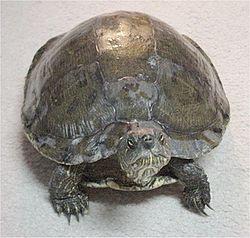| Texas river cooter | |
|---|---|
 | |
| Scientific classification | |
| Kingdom: | Animalia |
| Phylum: | Chordata |
| Class: | Reptilia |
| Order: | Testudines |
| Suborder: | Cryptodira |
| Family: | Emydidae |
| Genus: | Pseudemys |
| Species: | P. texana |
| Binomial name | |
| Pseudemys texana Baur, 1893 | |
| Synonyms [2] | |
| |
The Texas river cooter (Pseudemys texana) is a species of freshwater turtle endemic to the U.S. state of Texas. It is found in the river basins of the Brazos, San Bernard, Colorado, Guadalupe, San Antonio, Nueces, and their tributaries. It is one of three species of cooters ( Pseudemys ) occurring in Texas, including the Rio Grande cooter ( Pseudemys gorzugi ) and the river cooter ( Pseudemys concinna ). [3]


